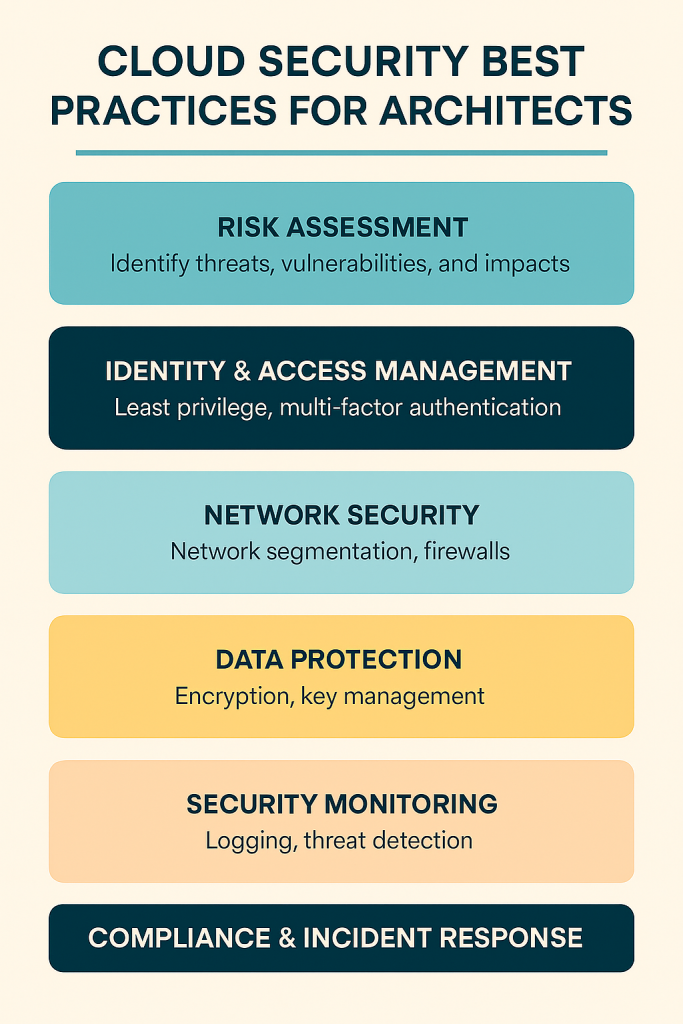Cloud Security Best Practices for Architects
Cloud adoption has accelerated across industries, but with it comes a complex set of security challenges. Architects play a critical role in designing cloud environments that are secure, resilient, and compliant. This guide outlines best practices that are both actionable and verifiable, helping architects build robust security into every layer of their cloud architecture.

1. Start with a Comprehensive Risk Assessment
Before designing any cloud solution, conduct a risk assessment to identify potential threats, vulnerabilities, and business impacts. This includes:
- Threat Modeling: Map out possible attack vectors and their likelihood.
- Attack Surface Analysis: Identify all points where an attacker could interact with your system.
- Business Impact Analysis: Understand the consequences of data loss, downtime, or breaches.
The Cloud Security Alliance recommends aligning this process with its Security Guidance for Critical Areas of Focus in Cloud Computing.
2. Apply the Principle of Least Privilege with Strong IAM
Identity and Access Management (IAM) is the backbone of cloud security.
- Use role-based access control (RBAC) to ensure users and services have only the permissions they need.
- Implement multi-factor authentication (MFA) for all privileged accounts.
- Regularly review and revoke unused credentials.
- For sensitive workloads, use just-in-time access to grant temporary privileges.
Microsoft Entra ID (Azure AD) and AWS IAM are examples of cloud-native IAM services that support these controls.
3. Design a Secure Network Architecture
A secure network design reduces the blast radius of potential breaches.
- Segmentation: Use virtual networks, subnets, and security groups to isolate workloads.
- Private Connectivity: Leverage services like Azure Private Link or AWS PrivateLink to keep traffic off the public internet.
- Firewalls and Gateways: Deploy cloud-native firewalls (e.g., Azure Firewall, AWS Network Firewall) and application gateways for traffic inspection.
- Zero Trust Networking: Authenticate and authorize every connection, regardless of origin.
4. Encrypt Data in Transit and at Rest
Encryption is a non-negotiable control for protecting sensitive data.
- At Rest: Use cloud-native encryption services such as AWS KMS or Azure Key Vault to manage keys.
- In Transit: Enforce TLS 1.2 or higher for all communications.
- Key Management: Rotate keys regularly and store them in secure, dedicated services.
OWASP emphasizes that encryption should be combined with strict access controls to prevent misuse.
5. Implement Continuous Monitoring and Threat Detection
Security is not a one-time setup. Continuous monitoring detects anomalies before they escalate.
- Use Security Information and Event Management (SIEM) tools like Microsoft Sentinel or AWS Security Hub.
- Enable cloud-native threat detection such as Microsoft Defender for Cloud or AWS GuardDuty.
- Set up automated alerts for suspicious activities, such as unusual login locations or privilege escalations.
6. Automate Security with Infrastructure as Code (IaC)
Automation reduces human error and ensures consistency.
- Define security configurations in code using tools like Terraform or AWS CloudFormation.
- Integrate security checks into CI/CD pipelines.
- Use policy-as-code frameworks (e.g., Open Policy Agent, Azure Policy) to enforce compliance automatically.
7. Secure Object Storage and Data Services
Misconfigured storage buckets are a common cause of breaches.
- Disable public access unless explicitly required.
- Use signed URLs for temporary access.
- Enable logging and versioning to track changes and recover from accidental deletions.
8. Plan for Compliance and Governance
Architects must ensure that cloud environments meet regulatory requirements.
- Map controls to frameworks like ISO 27001, NIST CSF, or GDPR.
- Use cloud-native compliance tools to assess and report on adherence.
- Document security policies and review them regularly.
9. Build for Resilience and Incident Response
Security architecture should anticipate failures and breaches.
- Implement redundancy and disaster recovery strategies.
- Maintain an incident response plan with clear roles and escalation paths.
- Conduct regular tabletop exercises to test readiness.
10. Stay Current with Evolving Threats
Cloud security is a moving target.
- Subscribe to threat intelligence feeds from your cloud provider.
- Participate in industry groups like the Cloud Security Alliance.
- Regularly review and update your architecture to address new vulnerabilities.
Final Thoughts
For architects, cloud security is not a bolt-on feature but an integral part of design. By following these best practices, from risk assessment to continuous monitoring, you can build cloud environments that are secure, compliant, and resilient against evolving threats.

Leave a Reply